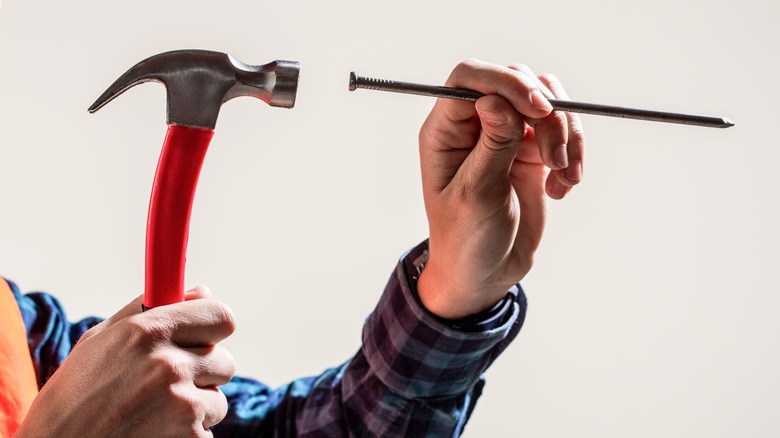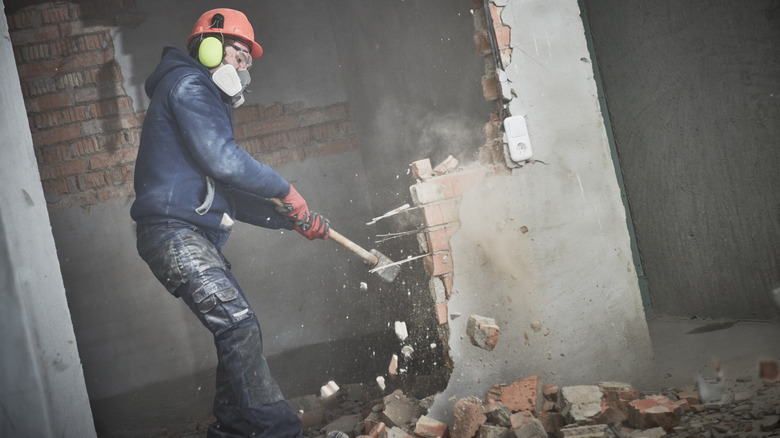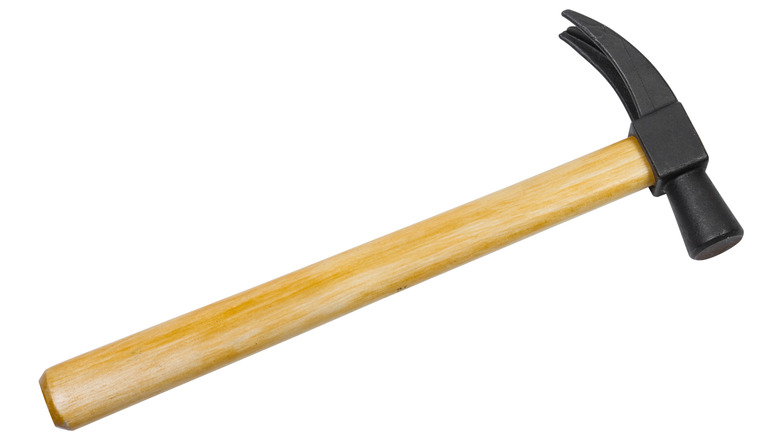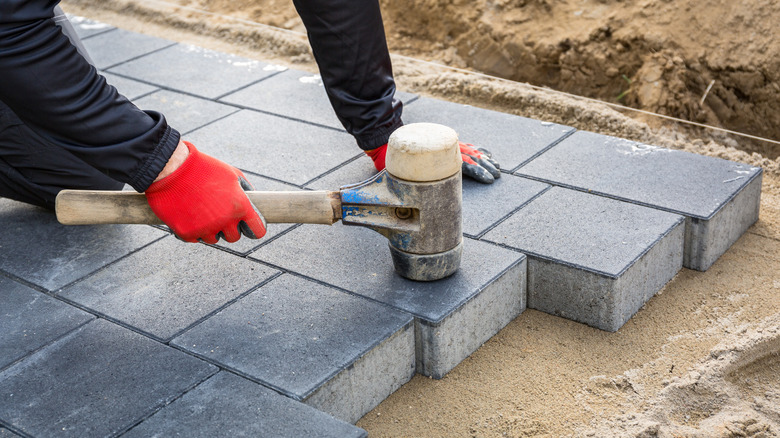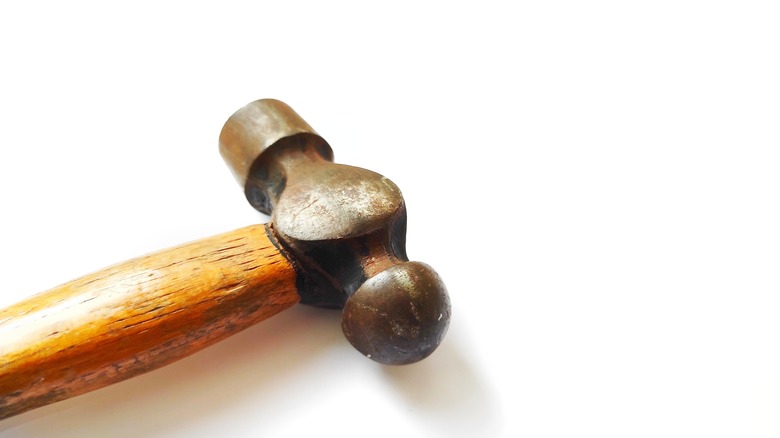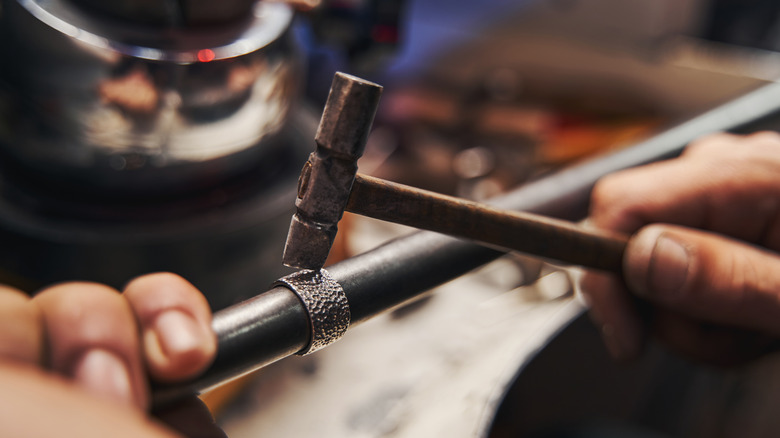How To Choose The Perfect Hammer For The Job
Hammers come in a wide variety of shapes, sizes, and head layout options. From the typical claw hammer that many homeowners have lying around their home to a more specialized option like a welder's chipping hammer, a number of different tools in this category likely enjoy a place in your toolbelt.
Calcagni Real Estate suggests that the typical homeowner should have at least two hammers in their arsenal: A standard claw-type hammer and a more delicate option (such as a pin hammer) for nuanced fastening tasks inside the home. The truth about any hammer is that specialization is formed through two distinct features. The head shape (or unique obverse side head addition) and the weight of a striking tool combine to create the specific force that may be required for any kind of job around the home. Selecting the appropriate hammer for the job at hand will ensure that you maintain a safe work environment and won't apply too much (or too little) force and potentially damage your home or the tool itself.
With these five types of home improvement tasks organized internally, you can always maintain a confident approach when lifting a striking tool to build, mold, fasten, or demolish something around your home.
Demolition
Demolition is perhaps the most enjoyable hammering task that a homeowner will engage in. There's just something satisfying about breaking down a wall, punching out brickwork, and the general destruction that comes along with these types of tasks. Video segments of homeowners and contractors destroying walls and other features with sledgehammers often make it into the finished product of home improvement shows and clips on the internet. However, it should be noted (via Fine Homebuilding) that sledgehammer use is often not the best way to go about interior demolition. Instead, these are often used in removing brickwork and other, similarly embedded features.
The name of the game when engaging in any type of demolition task is weight and size. When it comes to any kind of striking force, the farther away the mallet or cutting head is from your hand, the more force you can apply. A sledgehammer makes use of one of the longest handles of any hammer type for the same reason that felling axes and splitting mauls often incorporate long handles. Similarly, a sledgehammer will be one of the heaviest hammer tools in your toolbox as it uses very large striking faces to provide the biggest impact force possible. Professional demolition experts might also utilize a jackhammer for this type of task, which is another kind of hammering tool that automates the destructive power of a handheld sledge.
Standard DIY and building tasks
For a typical DIY task, the average homeowner will require a run-of-the-mill claw hammer. The typical DIY hammer will make use of a curved claw and a light- to medium-weight forged head. As with any other striking tool, the heavier your hammer, the more force you can apply to a surface. These hammers are typically used to drive nails and so the more substantial your nailing task is, the heavier your hammer must be. When driving very long nails into substantial blocks of wood, you'll want to be armed with a heavy-duty striking tool.
Many homeowners have more than one standard hardware store hammer in their toolbox or on a shelf in the garage. The Honest Carpenter reports that a different kind of claw hammer may be useful in standard DIY circumstances. A rip claw hammer looks very similar to a standard curved claw hammer, but the nail-pulling tool on the back is oriented in a straighter line of relief. This means that the weight of the claw sits directly behind the hammerhead and can help you improve both aim and leverage when striking a nail. Similarly, The Honest Carpenter notes that a rip claw hammer will typically leave a smaller depression (and possibly no trace at all) on softwoods when pulling nails.
Leverage or force applicator requirements
Another type of hammer that homeowners might already own, or perhaps need in the future, is one designed to apply careful force to another tool or delicate surface. A rubber mallet is a much better tool for striking a crowbar or chisel, for instance, than a standard homeowner's claw hammer (via Wrench Guru). Rubber or wooden mallets are the best way to apply precise force to another tool that must be struck against another material that you're working with. Chiseling away wood, driving a wedge, or pressing the claw end of a crowbar or cat's paw into a tight space to tear away material from a surface may all benefit from a softer hammering surface that still maintains significant weight and power potential.
These types of hammers aren't made to strike nails or to be used as a destructive force for breaking down elements in your home. Instead, they combine short handles with immensely heavy striking surfaces to produce a fine-tuned capacity for precise leverage in tight spaces or along edges. Similarly, when seating an axe head or hammerhead into a new handle, you'll need to use a soft mallet-type hammer to strike the bottom of the handle (via Fine Tools). The weight and head construction combine to give ample force capacity while eliminating the potential to damage a new handle for your tool.
Metal working and fabrication
A ball peen hammer is a specialized piece of equipment that many homeowners may have heard of but don't have in their toolboxes. This type of hammer is used for shaping metal and driving small pins (via Working the Flame). Avid DIYers might own one of these hammers and use them for small nail-driving needs or as a means to drive wedges into handles on other tools. In the same way that a rip claw hammer places the weight of the claw directly behind the head, a ball peen hammer condenses all the material weight behind the striking head for a compact swing and maximum impact potential. However, these types of hammers can be much lighter than many other standard striking tools and are therefore used as a nuanced impact force for driving small fasteners or for shaping purposes. The control that a user enjoys with this type of impact tool is virtually unparalleled.
These fabrication and metal manipulation tools can really round out the toolbox of a homeowner who engages in a variety of different DIY upgrades and improvements around their home. Rather than lumbering around a large claw hammer and trying to shorten your striking swing to accommodate for a smaller impact requirement, a smaller hammer that's purpose-built for this type of job will keep you safe and accomplish the task with much greater consistency and ease.
Repair tasks
The last type of hammer that a homeowner might never have heard of is one that fits within the repair realm. Jewelry makers, welders, and tool makers all require highly specialized impact-creating tools that may be much smaller than the typical consumer's conception of what a hammer is and does. For instance, jewelry makers and repair professionals require miniaturized impact solutions that can be worked into small spaces in order to strike pins, fasteners, and other features that may be incredibly small. Kernow Craft notes that a ball peen hammer often fits within this conversation, but many other specialized tools are also standard in this world of finesse and precision.
This type of hammer may never factor into your typical homeownership routine, but it's still important to understand what these tools can accomplish in case you run into a situation that might require a specialized addition to your toolbox. As with any task that you may encounter, using the right tool for the job is always the best approach when trying to get something done efficiently, effectively, and safely. Understanding what kind of jobs might require this type of specialized tool will help you avoid trying to tackle the task with the wrong kind of hammer and potentially hurting yourself or damaging your property in the process.
